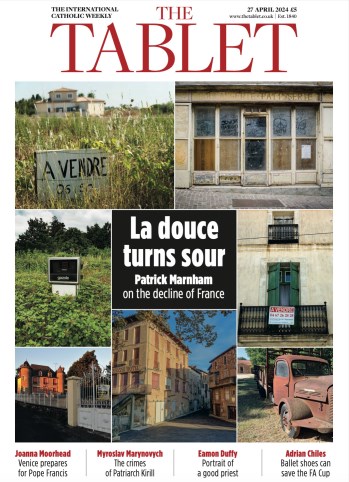For years the deconsecrated Palladian chapel in the grounds of Bretton Hall, home of Yorkshire Sculpture Park, stood empty, until funds were raised last year for its restoration and reopening as an exhibition space. Today, in a sign of its change of use, an Iron Tree by Ai Weiwei faces the traditional churchyard yew across the entrance and two video works by Bill Viola – Tristan’s Ascension and Fire Woman – are playing on a loop above the altar.
With his Martyrs triptych unveiled at St Paul’s Cathedral in London last year, Viola was an obvious choice of artist to show in the chapel. But when YSP invited him, it was a long shot. Would an international art star deign to exhibit in a remote, if hugely popular, sculpture park outside Wakefield?
The answer, when Viola saw the place, was a resounding “yes”. The resulting show (until 10 April 2016) has overflowed from the chapel into the Underground Gallery and is the largest British survey of the artist’s work since The Passions at London’s National Gallery in 2003.
Arranged in a Stations-like sequence, the YSP exhibition takes the form of a spiritual journey with stops for contemplation before 10 large-scale video works. The most recent, The Trial, was created this year and the oldest, The Veiling, in 1995.
The 1990s marked a watershed in Viola’s work. In his earlier video and sound works, he experimented with ideas of perception, but in 1991 – the year his mother died while his wife and collaborator Kira Perov was pregnant with their second son – he suddenly realised, recalls Perov, “that his art was actually his life and that he could bring the personal into the studio”.
As a student at Syracuse University, Upstate New York, in the 1970s, Viola had nursed a secret interest in mysticism but had kept his spiritual light under a bushel. Now he directed its full beam towards a search for the meaning of life.
He absorbed the teachings of Zen masters, Sufi scholars and Christian mystics such as St John of the Cross, read the ancient Egyptian Book of the Dead and studied Aristotle’s theories of time and change, and the Stoic philosophy of the rational soul. And despite the cutting-edge modernity of his medium, the principal materials of his art remain the four elements of early Greek philosophy: earth, air, fire and water.
The symbolism of water has run deep in Viola’s psyche since a near-drowning experience as a child. It features in half the works in the exhibition: as a curtain through which figures pass between life and death in Three Women and between adolescence and adulthood in The Innocents; as a cleansing downpour in The Trial and a magical waterspout facilitating Tristan’s Ascension; and as a watery bed or grave for seven portraits of Dreamers suspended between sleep and death.
As a schoolboy, Viola impressed a teacher with a drawing of a tornado, and he retains a fascination with the sort of elemental imagery the eighteenth-century philosopher Edmund Burke categorised as sublime. But despite his access to all the technical resources of the Hollywood disaster movie, he has no wish to strike fear or awe into his audience – he sees water and fire as forces of purification and transformation rather than destruction.
In Tristan’s Ascension, the hero is lifted from his watery tomb by the saving force of an inverted torrent; in Fire Woman, the heroine stands unharmed before a wall of fire, like a flameproof St Joan. Viola’s work is about acceptance, endurance and resistance – being tried in the fire and emerging on the other side.
“Experiential” is a rather clumsy word often used in connection with Viola’s work. The experience of his slow-motion films with their evocative soundtracks is immersive. The recurring imagery and the repetitive movements of distant figures, cyclically moving into close focus and out again as they shift between grainy monochrome and saturated colour, has the hypnotic effect of dissolving conscious thought.
“The work that artists really do”, he tells me, “comes from the gut. Head guys, they think they’re the best but they’re not. Emotion is the centre of creativity and people sometimes don’t realise it.”
It may seem blasphemous to mention Viola in the same breath as Tracey Emin, but both are contemporary artists who owe their enormous popular success to their readiness to express emotion in a contemporary art world dominated by ironic “head guys”. They both make work about loneliness and loss with a focus on the solitary being. The difference is that the solitary being, in Emin’s case, is the artist herself, whereas Viola’s subject is the common man or woman. And while Viola believes, with Emin, that art is about life, he feels it should be about more than life on earth.
Viola’s videos move people to tears because they offer a promise of salvation from “the oblivion of nothing”. He is a purveyor of non-denominational devotional art to the video generation, an artist whose work, claims John G. Hanhardt in a new monograph, reminds us of “the redemptive power of the aesthetics of belief”. Belief in what exactly? It doesn’t seem to matter.
10 December 2015, The Tablet
Moving images
La douce turns sour
 Loading ...
Loading ...
Get Instant Access
Subscribe to The Tablet for just £7.99
Subscribe today to take advantage of our introductory offers and enjoy 30 days' access for just £7.99





What do you think?
You can post as a subscriber user...
User Comments (0)